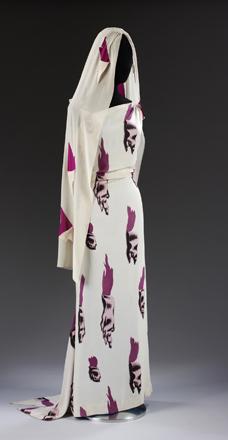

 Elsa Schiaparelli
Elsa SchiaparelliThe act of decoration is merely the process of making something more ‘attractive’-however what to categorise as ‘attractive’ can be a debated topic. For this particular task I strayed in the field of predictability when it came to creating decorative elements that were ‘attractive’-such as something as cliché as rosettes.
Integrate- to join two or more objects or make something part of a larger whole, or be joined or made part of a larger whole. I am more interested in decorative techniques as a textile form as opposed to an application. But for the sake of experimentation I intended to incorporate both decorative and integrated methods of decoration for the nanna briefs.
Whilst investigating the ‘decorate or integrate nanna’ task I came to discover just how widely decoration is used. The simplest of garments can be made extravagant purely through decorative elements, not to say I am largely in favour of this but I am able to appreciate some decorative works and admire their beauty.
I recently have been quite interested in the work of surrealists and their theoretical views, in pursuing this research I stumbled upon a fashion designer Elsa Schiaparelli who produced some of her best known works in collaboration with Salvador Dali. Her designs created in the art deco period had fascinating use of decoration which really inspired me for the nanna exercise. There was some kind of a minimalist sense conveyed ironically, as who would have categorised decoration with minimalism. . Her decorative elements also appeared as if they were strategically placed with precise calculation.
The term minimalism is also used to describe a trend in where the subject is reduced to its necessary elements; in this case ornamentations being about quality rather than quantity. Thus I decided to take this approach for my nanna briefs rather than ‘over decorating’ –I felt there would be a more refined beauty achieved.

Surprisingly I enjoyed the process of constructing the decorative nanna briefs. Whilst in class, I experimented with different ways of creating a textile surface through smocking and tucking. The process I found most effective was making textile out of a series of overlapping tucks travelling in different directions. It created an interesting texture and made one wonder and ask ‘how was this achieved?’. Thus I thought to continue this approach on my toile. I initially wanted the entire back piece to be made out of the tucks. I thought the best way to do this would be to get the fabric and then place the pattern and cut the piece out- in that chronological order. However I wasn’t aware of how much fabric it would actually take to fill the pattern piece. The fabric dramatically shrinked in size after the tucks were completed. Due to this being a tedious process and extremely time consuming I opted to incorporate the tucks into the side panels of the nanna, and thus make it a minor detail of the nanna.
Throughout this generic garment investigation I have learned that achieving your desired/intended result proves to be an immense challenge (for myself at least). Largely due to either the complexities of design or in most cases the behavior of the stretch fabric which is rather hard to predict and would require several toile’s before coming across anything close to perfection. Conversely I have learned to accept this and embrace it, as Salvador Dali says “Have no fear of perfection - you'll never reach it……………………Mistakes are almost always of a sacred nature. Never try to correct them. On the contrary: rationalize them, understand them thoroughly. After that, it will be possible for you to sublimate them. “









No comments:
Post a Comment